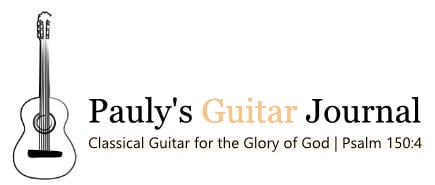To begin with, there are a lot of ways to write a fingerstyle song. There are a few essentials you need to know as far as chords, structures, etc. To discuss the very basics of composition we need to dive into a small bit of music theory. In this article, we will do an overview of basic music theory. Then we will talk about a few starting points for composition. With this brief introduction in mind, let’s dive in.

Learn the Key
The first thing is probably the most obvious. You need to know something about chords and keys, i.e. music theory. Music theory is not hard to learn, especially when taught by a good teacher. Unfortunately, many guitarists are intimidated by the concept. I have even seen some online “teachers” suggest skipping music theory altogether. Please don’t do that. Even some basic music theory will take you a long way in composing. Let’s take the infamous C Major for example, it is simply the letters of the alphabet with no flats or sharps: C-D-E-F-G-A-B-C (Bonus tip: A Natural Minor is the relative minor key of C Major, i.e. all the same chords). Why?
In Western music, a major scale is built on a pattern of intervals. An interval is the space between the notes. A whole step would be two frets on the guitar. A Half-Step would be one fret on the guitar. The pattern for the major scale is this: Whole-Whole-Half-Whole-Whole-Whole-Half (W-W-H-W-W-W-H).
Each note (letter) in the key is assigned a number. The number is called a Scale Degree and represents where the note (letter) is in relation to the root note. In our case the root note is C. The Scale Degree (number) assigned to the root note is 1. So, if we assigned all the notes a Scale Degree in the key of C Major, it would look like this:

Learn to Build Basic Triads
Simple Method
Now that we have the notes of the scale assigned to their respective degrees, we can build chords. A simplified method to finding all the chords in a key is this: skip every other note. If we want to build a triad for C then the formula would be 1-3-5 or C-E-G. D would be 2-4-6. E would be 3-5-7. G would be 5-7-2. Why 2? When we get to 7 we go back to the beginning. If we jump over every other note, we would jump over C. A would be 6-1-3 and so on.
The pattern of major and minor chords for a major key is:

So, the chords in our key of C is:

This works for any major key. But, why?
Official Method
Chords are built with formulas that the music masters deciphered over the centuries by their God-given giftedness. The quality of the third degree is what determines whether the chord is major or not. The formula for a major triad is 1-3-5. It has a major third in it to make it a major chord. When we apply the formula to our C Major Scale degrees, we get C-E-G for C. This makes the C a major chord because the E is a major third from the root (which is C).
However, the chord for D is minor. Why? Well, everything here is built on the Major scale. The formula for a minor chord is 1-b3-5. The third degree is now a minor third. How did we get that? If you build a major scale starting with D (a D major scale) you get:

Notice that if we keep the pattern of W-W-H-W-W-W-H we get an F# and C#. If we apply our formula for the major chord (1-3-5) we get D-F#-G. If we apply our formula for the minor chord (1-b3-5) we get D-F-G. Since we do not have an F# in the key of C Major, the chord for D is a minor chord because the F is natural. Make sense? If not, leave me your question in the comments.
Everything is based on the major scales.
We Have Scales and Chords, Now What?
There are two types of triads: opened and closed (please note: we are not talking about the four types of chords, major, minor, diminished, augmented… yet). A closed triad would be notes that are grouped close together. For example: C-E-G are close together on adjacent strings. You can practice these chords all over the neck.
However, the other type of triad is called the “open triad”. These chords are not close together, i.e. they are open. For example: a C major chord would be C-G-E. You would invert the 3rd and the 5th degrees giving you space between the notes.
Both types of chords can be played as major and minor. I would encourage you to learn all the open triads and positions on the neck. It will not take you much time.
A Word About Inversions
These triads can also be played in “Inversions.” An Inversion is simply a chord with a note other than the root in the bass. For example, a C major chord with an “E” in the bass, rather than a “C” is in the first inversion. Likewise, a C major chord with a “G” in the bass is in second inversion. The same is true with minor chords.
Improvise with the Chords in the Key
Okay, you have the basics in chords and scales, i.e. music theory. Let’s put them together. Many, if not most western music is based on the I-IV-V-I chord progression. For our example, that would be C major, F major, G major, and then back to C major. You can add and substitute chords as you go. For example, you could substitute the two (ii) chord or the sixth (vi) chord for the four (IV) chord for a different feel and sound.
As you play around with different chord combinations. Try to keep in mind voice leading. Instead of having big jumps between notes, try smaller intervals and use inversions. Each time you move a chord to a different position or new chord, you have three options: Root position, 1st inversion, and 2nd inversion.
For example: Am with “A” in the bass to G/B (in the first inversion) to C major. The bass line moves from A to B to C instead of jumping from “A” to “C”.
Record the Idea
When you have come up with an idea that you like, open your phone’s Voice Memos app (or any type of simple recording device that you can keep up with). I have Voice Memos on the iPhone, so I use that.
Record your idea slowly. You may want to record the idea and then play it again slowly so you speak the chords as you play. You may not come back to the idea for a while and this will make it easier to identify the chords you have played.
Save the idea with a title if you have one. In time you will come up with other ideas that fit together with this one and you will want to label them: Guitar Song 1, Guitar Song 2, etc. As of the writing of this blog, I’m working on a song called To the Next One, so I have my ideas labeled To the Next One 1, To the Next One 2, etc.
Notate the Song
Once you have all the song ideas recorded, say 3 to 5 ideas, notate (or tab) each one out. Don’t get caught up too much with the details at this point. Only notate what you have. As you do this you will see the bigger picture and then you will see how each might fit together. As you go, you’ll start to make edits to the song, keeping what works, modifying what “kind of” works, and tossing what doesn’t work.
Record the Finished Version
Once you have the song down and can play it fluently, it’s time to record it. You don’t have to have a professional music studio in your bedroom. You can use your phone to record. If you research ways to enhance the recording, it might be all you need. Once you have the piece recorded you can mark it as finished.




Comments ()